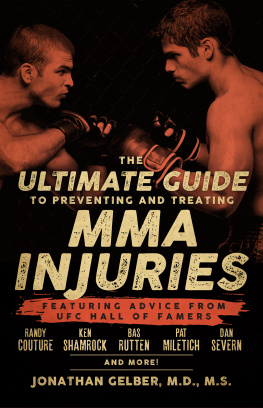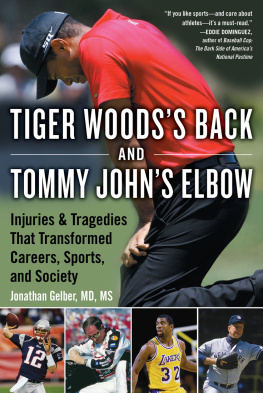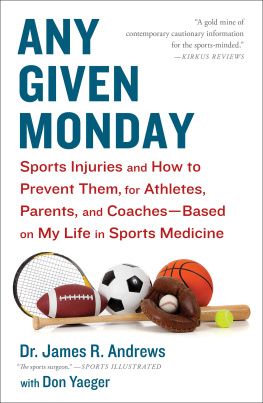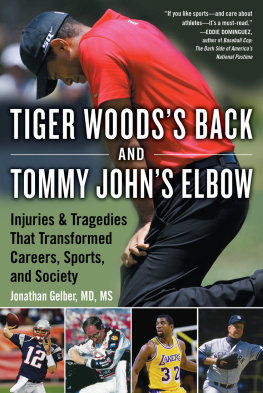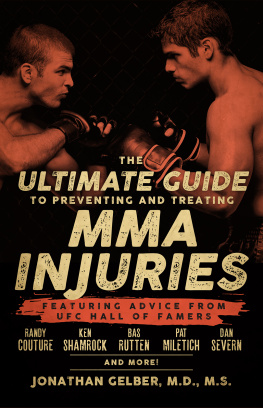FEATURING ADVICE FROM
UFC HALL OF FAMERS
RANDY COUTURE,
KEN SHAMROCK,
BAS RUTTEN,
PAT MILETICH,
DAN SEVERN
AND MORE!
JONATHAN GELBER, M.D., M.S.
TO MY WIFE, CHILDREN, AND PARENTS
FOR THEIR LOVE AND SUPPORT.
AND TO THE ATHLETES AND COACHES
WHO SACRIFICE FOR THE SPORT.
CONTRIBUTORS/INTERVIEWEES
(15 UFC TITLEHOLDERS 6 UFC HALL OF FAMERS, 32 MMA FIGHTERS, 7 ELITE TRAINERS, AND MORE)
Ken Shamrock (UFC HoF)
Frank Shamrock
Bas Rutten (UFC HoF)
Randy Couture (UFC HoF)
Sean Sherk
Dan Severn (UFC HoF)
Pat Miletich (UFC HoF)
Mark Coleman (UFC HoF)
Demetrious Johnson
Josh Barnett
Matt Serra
Carlos Condit
Carlos Newton
Tim Sylvia
Mark Hunt
Don Frye
Renzo Gracie
Gilbert Melendez
Matt Brown
Mario Sperry
Brandon Vera
Tim Kennedy
Dean Lister
Duane Ludwig
Jeff Monson
Pete Spratt
Stipe Miocic
Ed Herman
Nate Quarry
Guy Mezger
Patrick Ct
Matt Lindland
Stitch MMA and boxings legendary cutman
Ricardo Liborio Elite trainer/coach, co-founder American Top Team (ATT)
Cesar Gracie Elite trainer/coach, Cesar Gracie team
Mark DellaGrotte Elite trainer/coach, Team Sityodtong
Mike Winkeljohn Elite trainer/coach, Jackson-Winkeljohn team
Javier Mendez Elite trainer/coach, American Kickboxing Academy, (AKA)
Greg Nelson Elite trainer/coach, the Academy
Ray Longo Elite trainer/coach, Serra/Longo competition team
Big John McCarthy Referee and advocate
Bruce Buffer The Voice of the Octagon
Andy Foster Former fighter and California Athletic Commissioner
CONTENTS
FOREWORD BY A RINGSIDE DOC PIONEER
DR. JOE ESTWANIK
DR. JOE ESTWANIK, FORMER PRESIDENT AND CO-FOUNDER, ASSOCIATION OF RINGSIDE PHYSICIANS
As a young sports medicine doctor in the early 1980s, I was requested to assist as a ringside physician in a USA Boxing National Championship in my hometown. With my martial arts and wrestling background, I easily bonded with the athletes, coaches, officials, and refs. However, despite my enjoyment of the event, I felt something was off. The sports science available for this elite tournament was out of sync with what was then the current standard of sports medicine. I realized I needed to rapidly apply what we already knew in sports medicine to the boxing world. As I began to work on bringing science and medicine to the sport and to these athletes, I looked to my mentor Necip Apri, M.D. a wizard at the fight game. It was amazing how often he could accurately predict outcomes and injuries! Soon, true ringside medicine was born, and I was at the forefront.
My interest allowed me to serve as chairman of sports medicine for USA Boxing and travel the world with our team for many years, including to Russia at the height of the Cold War. Then, suddenly out of Brazil came an everything goes combat the early years of mixed martial arts. I quickly latched on to this great sport and was a ringside physician at UFC3 in 1994. Soon after, I worked as a team with the Gracie family, Big John McCarthy, and others to form MMA as we know it today. I helped establish rounds, referees, weight classes, and the number of fights per day for a competitor. I designed the original grappling glove with the help of my friends, particularly Big John McCarthy and John Perretti.
In the world of medicine, there is a standard of care that is applied to all athletes. These gold standards for injury prevention, recognition, and recovery are almost universally applied, irrespective of the sport. The knowledge currently available must be extended to and applied to athletes within traditional team sports, such as baseball, basketball, and football, as well as non-traditional and combat sports. A torn ACL in the knee of a football player is not different than a torn ACL in a wrestlers knee. A concussive impact from heading a soccer ball affects the same type of neurons disrupted from a punch that connects with a boxers head. The many systemic disruptions created by starvation, dehydration, and incomplete rehydration affect all athletes, including wrestlers, boxers, MMA fighters, or even military warriors.
However, one must also keep in mind that each sport generates injuries and mechanisms of injury specific to the training and competition of the respective athletes. For example, the chapter on shoulder injuries excellently details exposure to pressures on the shoulder joint commonly produced by martial arts/boxing demands that may not be found in other sports. MMA athletes deserve a sports medicine team familiar with the specific demands, rules, mechanisms of injury, and rehabilitation techniques unique to the combat arts. The team should include coaches, certified athletic trainers, strength/conditioning coaches, nutritionists, and physicians familiar with the sport of MMA. My advice is to search out a doctor familiar with the demands of your sport. At the time of writing this, the Association of Ringside Physicians in conjunction with the American College of Sports Medicine have created a certification in ringside medicine that may be one guide to help you find a doctor familiar with boxing/MMA. And always be wary of the doctor who would rather be your friend at an event than a doctor treating you as a patient.
As athletes, your responsibilities and duties span three time zones: pre-event, intra-event, and post-competition.
PRE-EVENT
Choose your correct certified weight class by measuring your body fat percentage using skin calipers or other measures of hydration. Wrestling coaches and athletic trainers have measured many tens of thousands of competitors and are familiar with the tools available. Be judicious in the amount and aggressiveness of sparring. Training harder does not mean sparring harder. It is known that many of Muhammad Alis detrimental impacts occurred during his vicious sparring sessions. Just as football coaches are recently limiting full-contact sessions, fighters should follow the same advice. Be honest to your coaches in declaring injuries, headaches, and concussions.
INTRA-EVENT
Just as the referee serves as a neutral judge of the rules, the ringside physician referees your immediate and long-term health and safety. Listen to the referee or fight doctor if he stops a fight and accept his decision. Its better to live to fight another day!
POST-COMPETITION
Cooperate with the ringside doctors instructions for follow-up care. Even sub-concussive (non-knockouts) require physical and mental rest. You should avoid celebrating with alcohol consumption for several days after a bout, as recent studies note impaired brain-cell healing with alcohol. Seek experts in injury rehabilitation, such as physical therapists who understand the specific demands of your sport.
This book by Jonathan D. Gelber, M.D., M.S., shares his interest and expertise in sports medicine to educate those involved in mixed martial arts. The dedicated athletes of this ancient art do not deserve ancient science. The sound advice provided by Dr. Gelber illustrates the gold standards that you so deserve.
JOSEPH J. ESTWANIK, M.D., FACSM
Author of Sports Medicine for the Combat Arts

